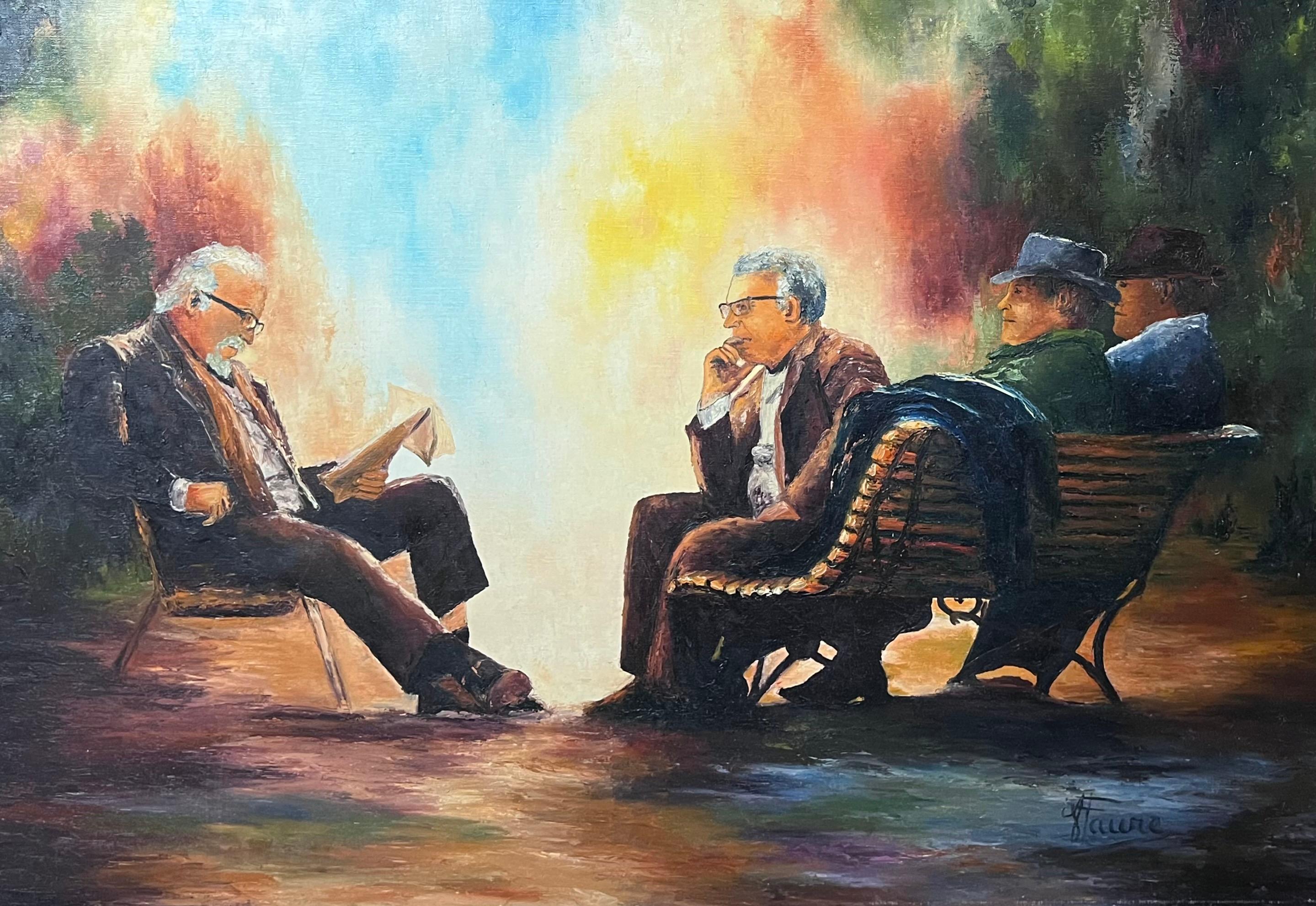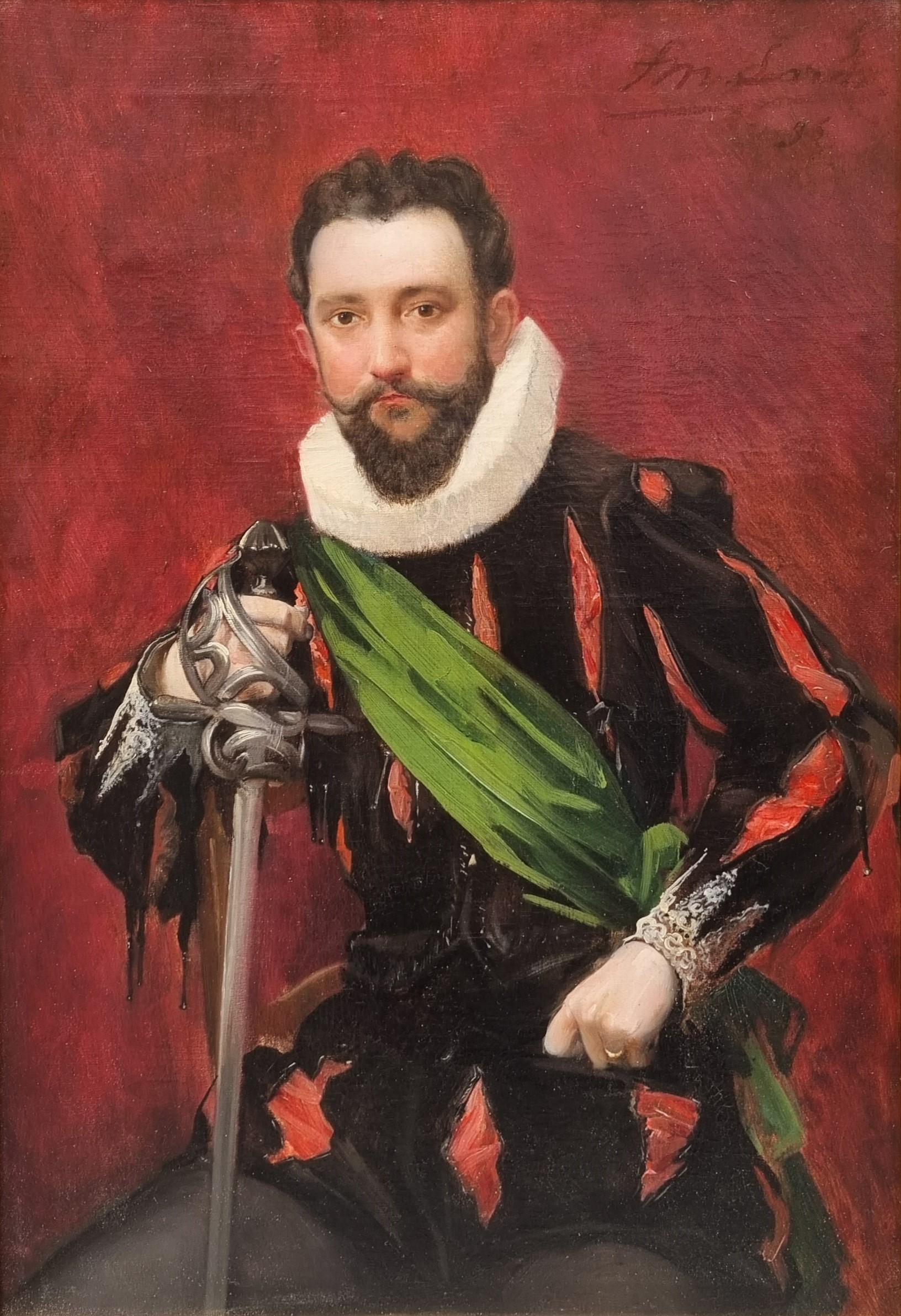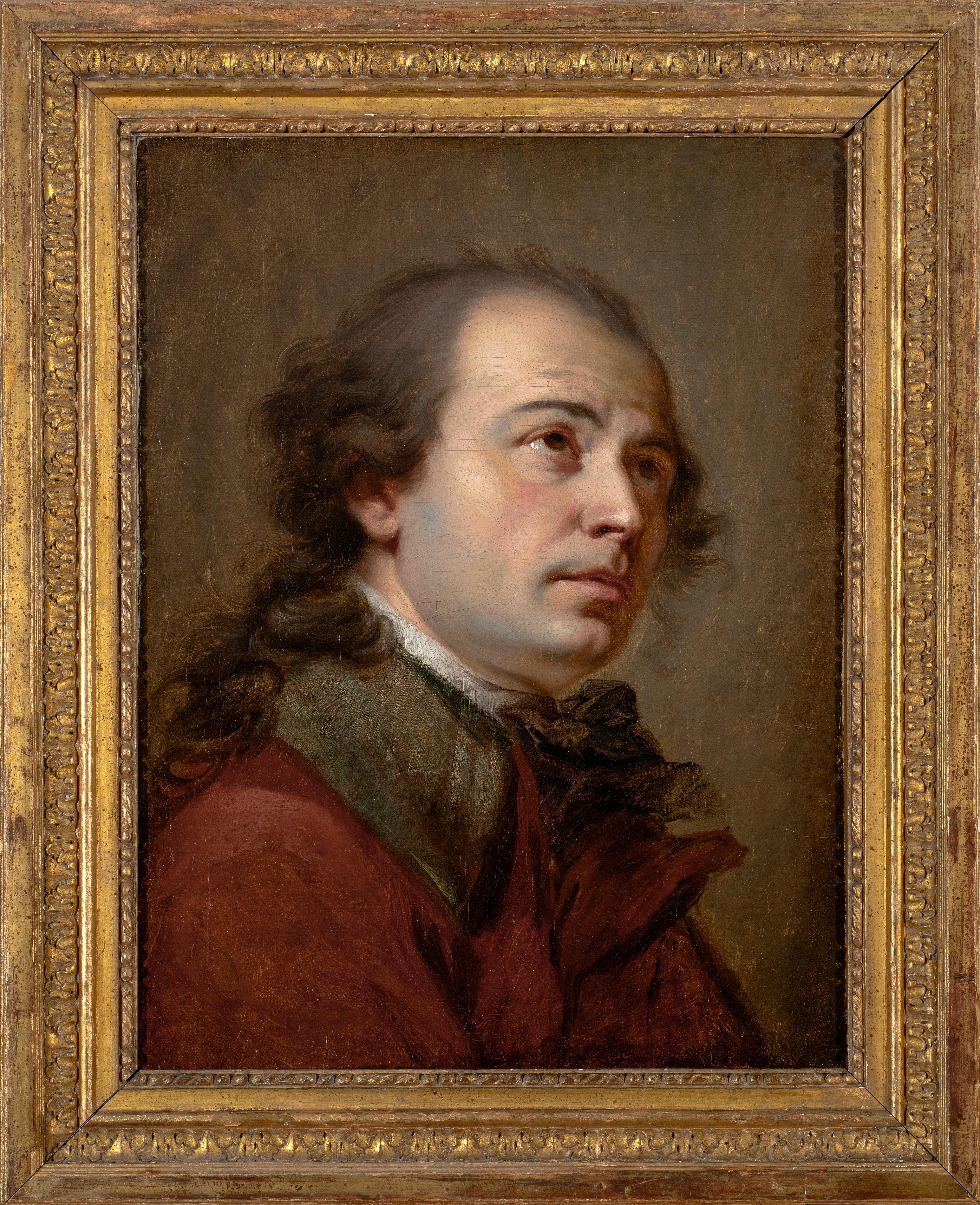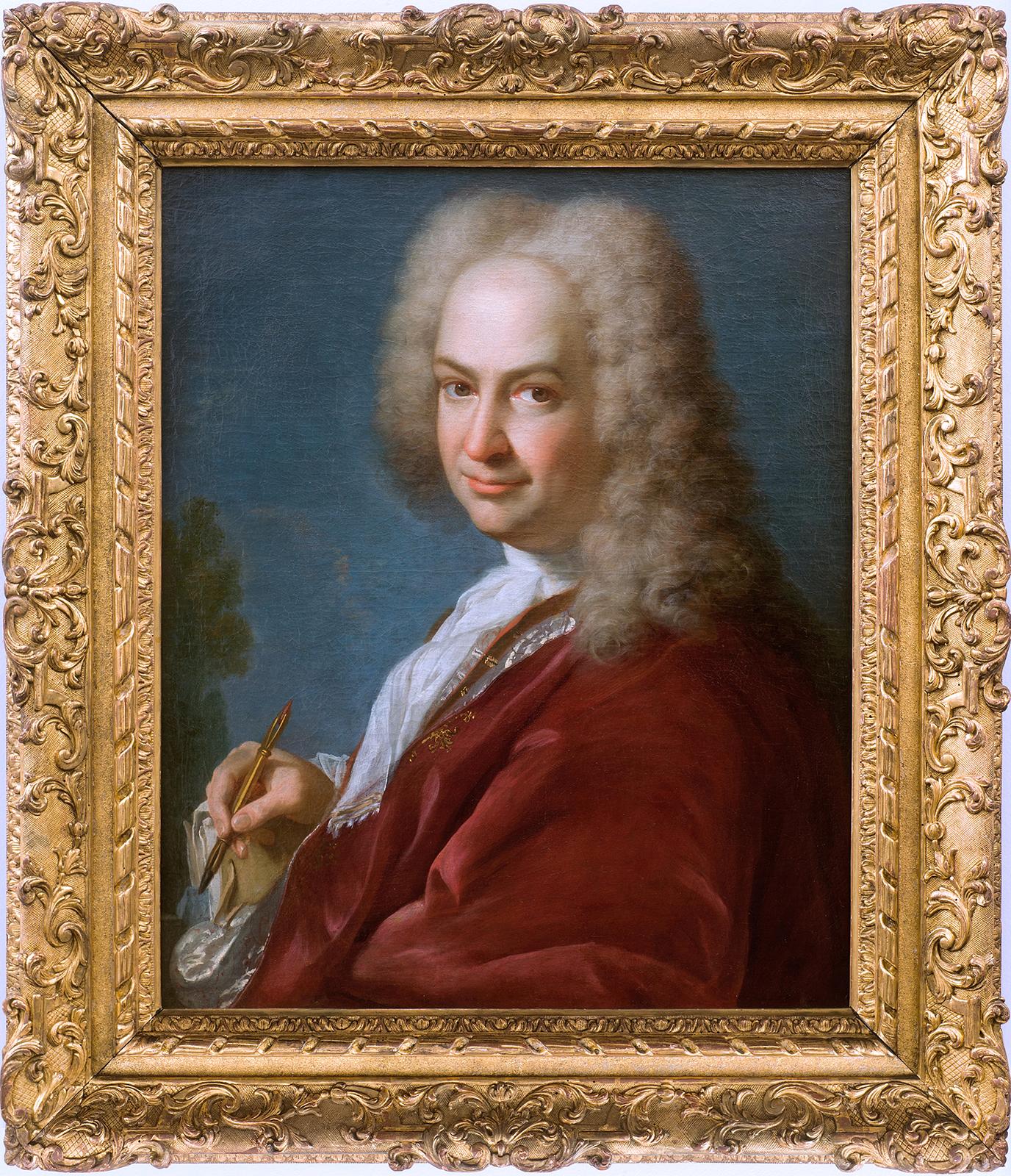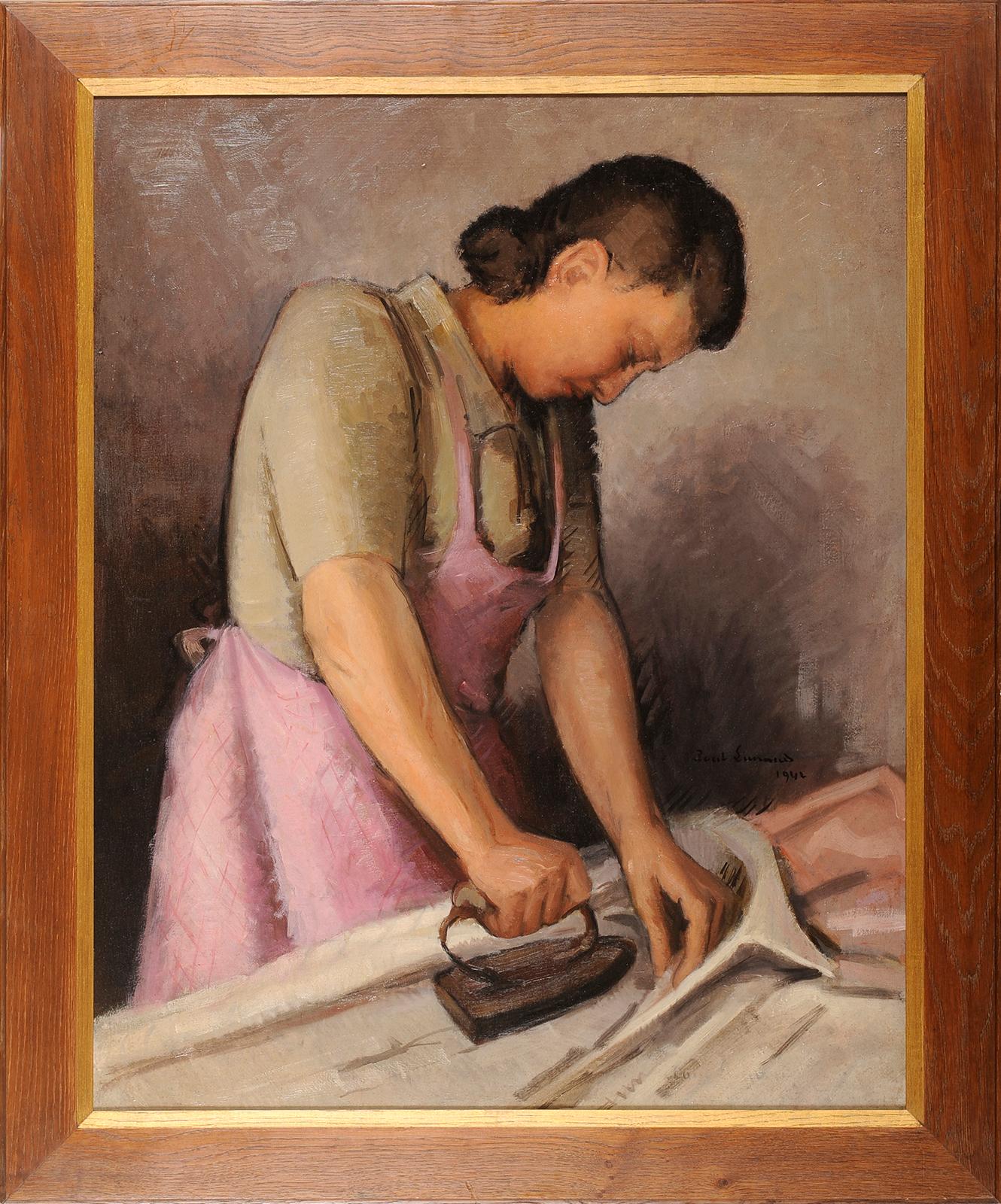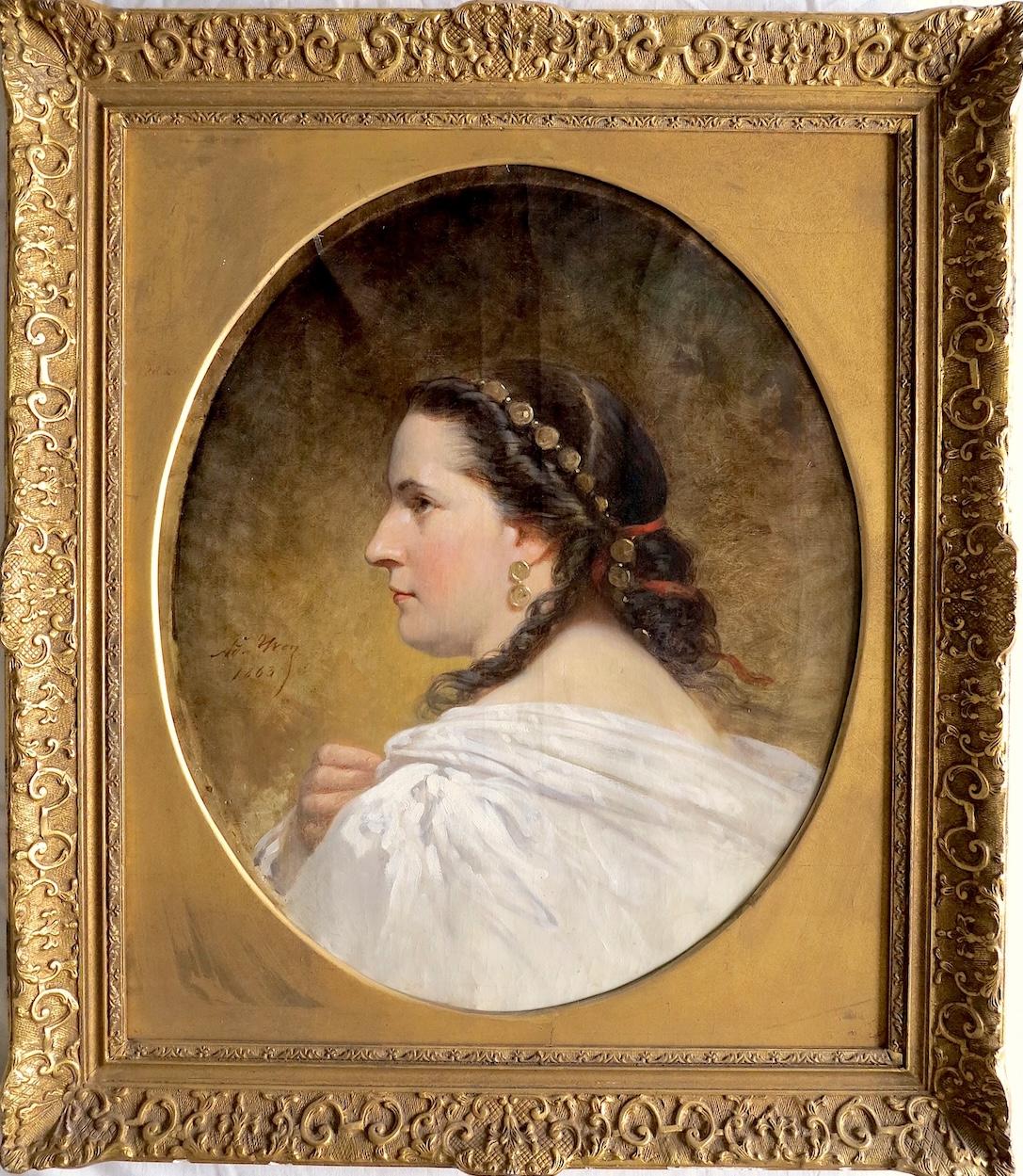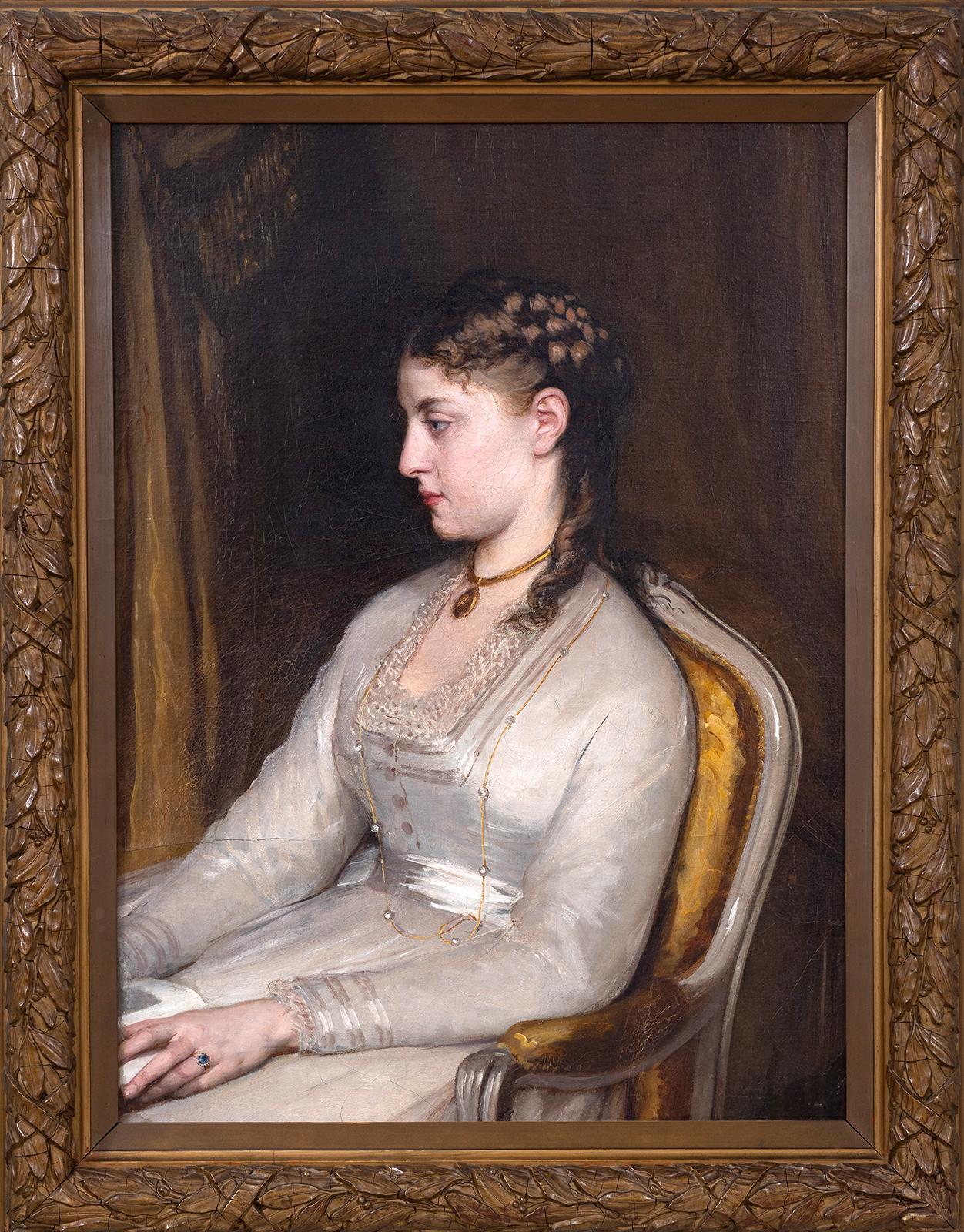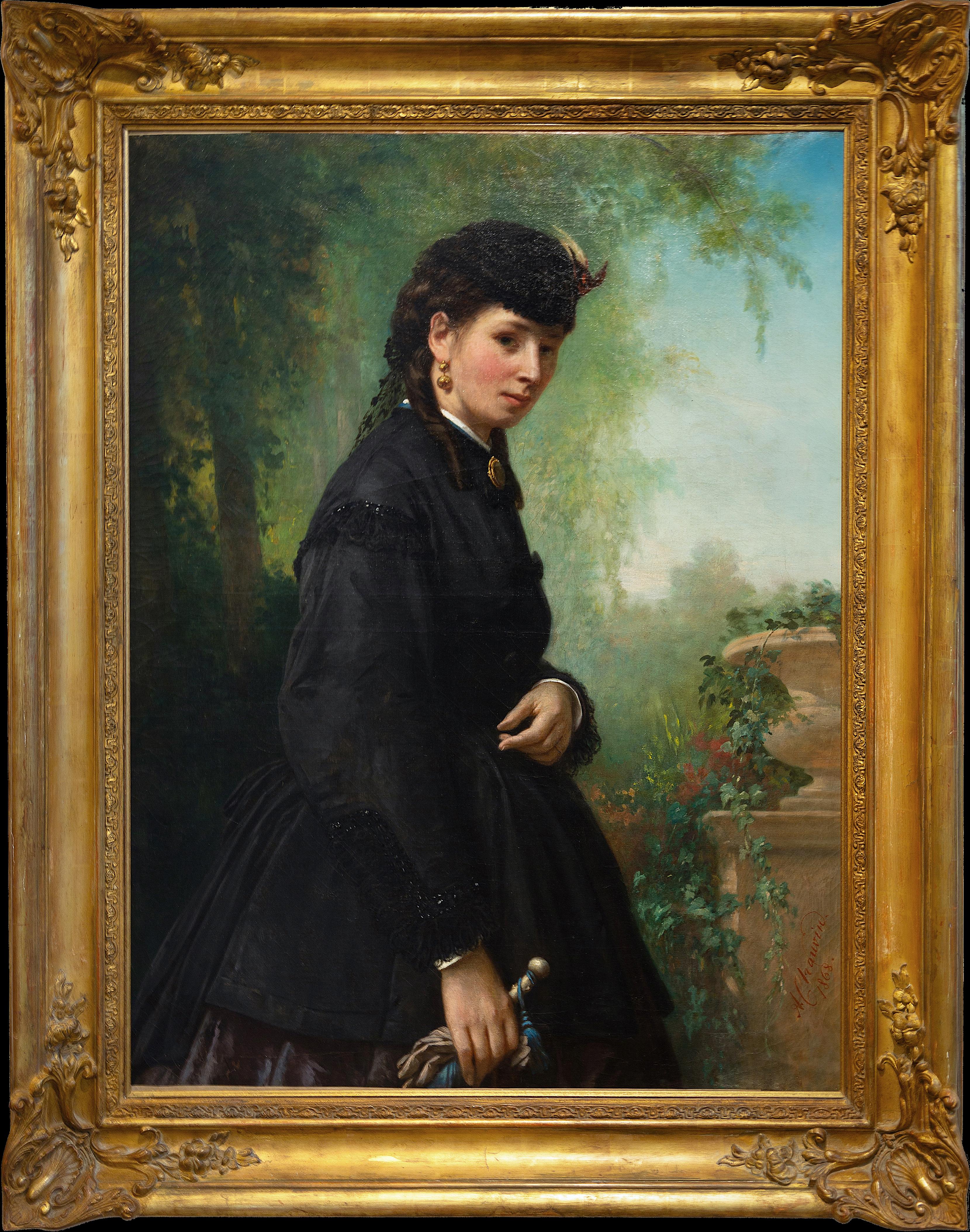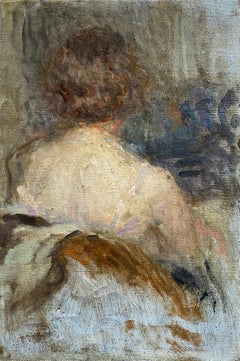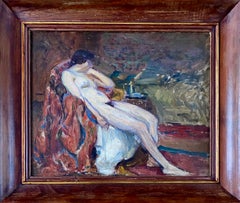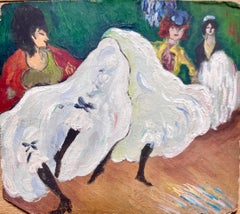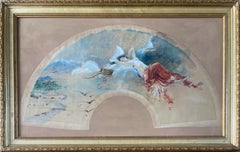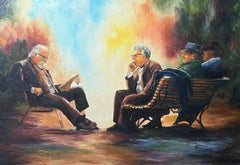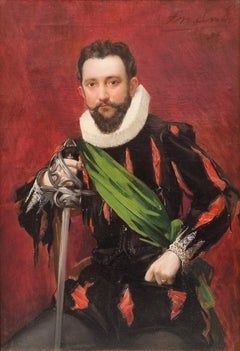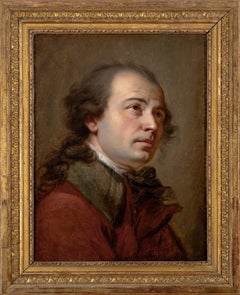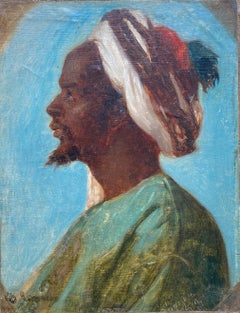
Portrait of a young Moroccan in profile
View Similar Items
Want more images or videos?
Request additional images or videos from the seller
1 of 4
Charles Zacharie LandellePortrait of a young Moroccan in profile1853
1853
About the Item
- Creator:Charles Zacharie Landelle (1821 - 1908, French)
- Creation Year:1853
- Dimensions:Height: 9.06 in (23 cm)Width: 6.89 in (17.5 cm)
- Medium:
- Movement & Style:
- Period:
- Condition:Very slight lifting of the paper should be noted as well only a small tear (no loss).
- Gallery Location:PARIS, FR
- Reference Number:1stDibs: LU2709214284622
Charles Zacharie Landelle
Charles Zacharie LANDELLE (Laval, 1821 – Chennevières/Marne, 1908) Son of employee of the prefecture of Laval, Charles Zacharie LANDELLE accompanied his father transferred to Paris in 1827. He will not then return to Laval until the end of his life in 1895 for the inauguration of a museum of painting. Admitted in 1837 to the Ecole des Beaux-Arts, he followed the teachings of Paul DELAROCHE and Ary SCHEFFER. His career began with the production of portraits and large religious compositions - notably for the Saint-Nicolas-des-Champs, Saint-Sulpice and Saint-Roch churches in Paris - which were an immediate success and enabled him to gain recognition from the high society of the nineteenth century. He began at the Paris Salon of 1841 with a self-portrait noticed by Louis-Philippe, obtained a third class medal the following year and a first class in 1848. LANDELLE was also awarded at the Exposition Universelle of 1855 in Paris, and in Philadelphia. From then on he was able to follow a career as an official painter, between state commissions and portraits of the great people of his time (Portrait of Alfred de MUSSET, kept at the Palace of Versailles). Napoleon III bought him two paintings of the Beatitudes at the Salon of 1852 to donate to Laval, birthplace of the artist and hired him to participate in the decoration of the Salon des Aides de Camp at the Palais de l'Elysée. As early as the 1850s, LANDELLE discovered the Orient by his travels; especially Morocco, where he will have the opportunity to return on an official mission in 1866. He then realized on his return his famous Femme fellah, a work bought by the Emperor on his personal cassette, and unfortunately destroyed in 1870 in France. fire of the Château de Saint-Cloud. He then participated in a trip to Egypt in 1875, and went down the Nile with the Egyptologist Auguste MARIETTE. In 1880, LANDELLE discovered Algeria accompanied by his son Georges, also a painter. Conquered by the place, he decided each year between 1881 and 1892 to spend his winters in Algeria and to bring back some paintings or studies. LANDELLE was made knight of the Legion of Honor. Museums: Amsterdam (Mus. mun.), Londres (Wallace Coll.), Paris, (Mus. du Louvre, Mus. d’Art Mod.), Sydney, Angers, Caen, Compiègne, Laval, Nantes, Pau, Perpignan, Reims, Rouen, Strasbourg, Stuttgart, Versailles…
About the Seller
5.0
Vetted Professional Seller
Every seller passes strict standards for authenticity and reliability
1stDibs seller since 2024
5 sales on 1stDibs
Typical response time: 1 hour
Authenticity Guarantee
In the unlikely event there’s an issue with an item’s authenticity, contact us within 1 year for a full refund. DetailsMoney-Back Guarantee
If your item is not as described, is damaged in transit, or does not arrive, contact us within 7 days for a full refund. Details24-Hour Cancellation
You have a 24-hour grace period in which to reconsider your purchase, with no questions asked.Vetted Professional Sellers
Our world-class sellers must adhere to strict standards for service and quality, maintaining the integrity of our listings.Price-Match Guarantee
If you find that a seller listed the same item for a lower price elsewhere, we’ll match it.Trusted Global Delivery
Our best-in-class carrier network provides specialized shipping options worldwide, including custom delivery.More From This Seller
View AllWomen seen from behind
By Ernest Laurent
Located in PARIS, FR
Ernest LAURENT
Gentilly 1859 - Bièvres 1929
Seated woman seen from behind, preparatory sketch
Oil on cardboard
Circa 1920
32 x 21.5 cm
unframed
Our oil o...
Category
1920s Post-Impressionist Portrait Paintings
Materials
Canvas, Oil, Cardboard
Female Nude In An Interior
Located in PARIS, FR
Maurice TASTEMAIN
Caen 1878 - Paris 1944
Female nude in an interior
Oil on panel
Signed lower left
32.5 x 41 cm panel
45 x 53 cm frame
good condition
A student of Ménégoz at the Éc...
Category
Early 20th Century French School Nude Paintings
Materials
Oil, Panel
The French Cancan
By (after) Pablo Picasso
Located in PARIS, FR
French School
Around 1900
The French Cancan, rework with variations of a composition by Pablo Picasso
Oil on cardboard
32 x 26 cm unframed
Damaged and cut corners (lower left), good...
Category
Early 1900s French School Figurative Paintings
Materials
Oil, Cardboard
$2,662
Hand Fan Project With The Goddess Diana The Huntress floating in the clouds
By François Flameng
Located in PARIS, FR
François FLAMENG
Paris 1856 - 1923
Diana the Huntress floating in the clouds, fan project
1893
Watercolor and gouache on wove paper
Signed and dated lower right
25 x 70 cm sheet (le...
Category
1890s French School Figurative Drawings and Watercolors
Materials
Watercolor, Gouache
View of Pairs, The Clock Tower And The Conciergerie
Located in PARIS, FR
Geroges-Grançois Guiaud
Paris 1840 - 1887
The clock tower and the Conciergerie in Paris
Around 1870
Watercolor
Signed lower left
54 x 34 cm sheet
66 x 47 cm frame
Frame from the Nap...
Category
1870s French School Landscape Drawings and Watercolors
Materials
Watercolor
Throw of flowers, nasturtiums
Located in PARIS, FR
Blanche ODIN
Troyes 1865 - Bagnères-de-Bigorre 1957
Throw of flowers, nasturtiums
Watercolor on paper
Signed lower right
25 x 16.5 cm sheet
37 x 30.5 cm frame
Category
Late 19th Century French School Still-life Drawings and Watercolors
Materials
Watercolor
You May Also Like
Portrait of Three Men Discussing The Newspaper 20th Century French Oil Painting
Located in Cirencester, Gloucestershire
Gentlemans Discussions
by Annie Faure (French 1940-2021)
signed lower corner
oil painting on canvas, unframed
canvas size: 24 x 35.5 inches
condition: overall very good, minor surfac...
Category
Late 20th Century French School Figurative Paintings
Materials
Oil
Portrait of a young woman, circa 1935
Located in PARIS, FR
Mercédès LEGRAND (1893-1945)
Portrait of a young woman ; assumed to be the artist's daughter, circa 1935
Oil on panel (carton bouilli)
Signed lower left
36 x 29 cm
Born in Spain in ...
Category
1930s French School Portrait Paintings
Materials
Oil
Realist Painting Portrait French actor Comedie Française LARD 19th
Located in PARIS, FR
François Maurice LARD
Paris, 1864 – Paris, 1908
Portrait of the actor Raphaël Duflos as Ruy Blas
Oil on canvas
55 x 38 cm (67 x 49 cm with the frame)
Signed and dated top right “FM L...
Category
1890s French School Portrait Paintings
Materials
Oil
Tête d’expression portrait study of a gentleman
Located in Maidenhead, GB
French Academic School, 18th century
A tête d’expression study of a gentleman, c. 1780-90
Oil on canvas
46.1 x 35 cm.; (within frame) 57.5 x 46.6. cm.
Provenance:
Private Collectio...
Category
1780s French School Portrait Paintings
Materials
Oil
Retrato femenino - Óleo sobre tela
Located in Sant Celoni, ES
La obra va firmada va con el sello del atelier en la parte trasera
Se presenta bien enmarcada la pintura
El estado de la obra es bueno
Medidas de la obra: 41 x 32 cm.
Medidas del...
Category
1920s French School Portrait Paintings
Materials
Oil
Presumed artist self-portrait
Located in BELEYMAS, FR
Louis-Gabriel BLANCHET
(Versailles, 1701 – Rome, 1772)
Presumed self-portrait of the artist
Oil on canvas
H. 73 cm; W. 60 cm
Circa 1730
Originally presented in a Restoration period frame with a "Mignard" cartouche, this beautiful painting initially appeared to us as a work from northern Italy. However, it exuded a rather French form of refinement, suggesting that its artist may have assimilated a dual influence from both sides of the Alps.
We thank our colleague and friend Philippe Mendès for spontaneously and judiciously "bringing out" the name of Louis-Gabriel Blanchet, a Romanized French portraitist, whose spirit and stylistic characteristics we clearly recognize here.
Blanchet's "French" years, before his final departure for Rome in 1728, following his winning of the second Grand Prix for painting after Subleyras in 1727, are extremely poorly documented. His father, Gabriel, was valet to Blouin, himself Louis XIV's first valet at the time. According to Thierry Lefrançois, Blanchet was one of the few students of Nicolas Bertin (1667-1736), whose studio he is said to have joined in the early 1720s. At a baptism on March 24, 1724, where he was godfather, he is mentioned as a painter in the picture store of the Duke of Antin, the director of buildings between 1708 and 1736. At this time, he was probably already married to Jeanne Quément, with whom he had a daughter also named Jeanne, who would marry Nicolas Aviet, the son of a valet in the queen's wardrobe, in Versailles in 1738.
When Blanchet arrived in Rome in October 1728, he was accompanied by Subleyras, Trémolières, and Slodtz. He enjoyed the goodwill of Vleughels, the director of the Académie de France, which had been based at the Palazzo Mancini since 1725, even though the latter was not always kind to our resident. From 1732, he was under the protection of the Duke of Saint-Aignan when he took up his post as ambassador to Rome. Along with Slodtz and Subleyras, they formed a trio of friends, joined by Joseph Vernet shortly after his arrival in Rome in 1734. Slodtz and Blanchet, on the occasion of Subleyras's marriage in 1739, were there to attest that their friend was not bound by any marital commitment, and Blanchet was a witness at Vernet's wedding in 1745.
It is most likely from these early years in Rome that our portrait of the artist dates, the expression and turn of his face irresistibly reminiscent of a self-portrait. The still relatively youthful features may correspond to Blanchet's thirty-something years, and the fluffy wig was still fashionable at this time.
The painting fits well with the depiction of a young painter wanting to display both the beginnings of success and a certain simplicity or restraint. A slight smile expresses a form of assurance in this man with a gentle, sincere gaze and a face radiating a keen sense of wit. We find here the air of intimacy present in almost all of Blanchet's portraits, even those from the 1750s and 1760s, as well as an almost complicity with the viewer. The spirit of the painting is quite close to that of the presumed portrait of Bouchardon (painted around 1730) and the portrait of Pannini, painted in 1736, but it possesses a more natural quality, notably thanks to the absence of decorum. Our work exhibits the characteristics of Blanchet's paintings: elegance, luminosity (especially in the whites), vibrant and refined colors (here, the harmony of the garnet of the garment and the slate blue of the background, whose uniformity is tempered by a very sketched landscape and a grove of greenery), light complexions, rather rosy cheekbones, often full lips, and rather tight framing.
According to the Academy's rules, Blanchet's stay should have ended in the spring of 1732, but, for reasons unknown, he remained in the Eternal City until his death, as did his friend Subleyras, with whom he shared accommodation until the late 1730s. The latter regularly called upon him to collaborate on his paintings, such as The Meal at Simon's. Through Saint-Aignan's intervention, Blanchet was employed in the late 1730s by the Stuart princely family, then exiled in Italy. He notably produced copies (now lost) after Liotard of the portraits of Charles Edward and Henry Benedict, the sons of James III Stuart. The latter also commissioned three other portraits (now in the National Portrait Gallery in London), whose more formal character contrasts with the intimate spirit of Blanchet's portraits. Blanchet frequented English painters, such as the landscape painter Richard Wilson, and studied with the Scottish portraitist Katherine Read...
Category
1730s French School Portrait Paintings
Materials
Oil, Canvas
